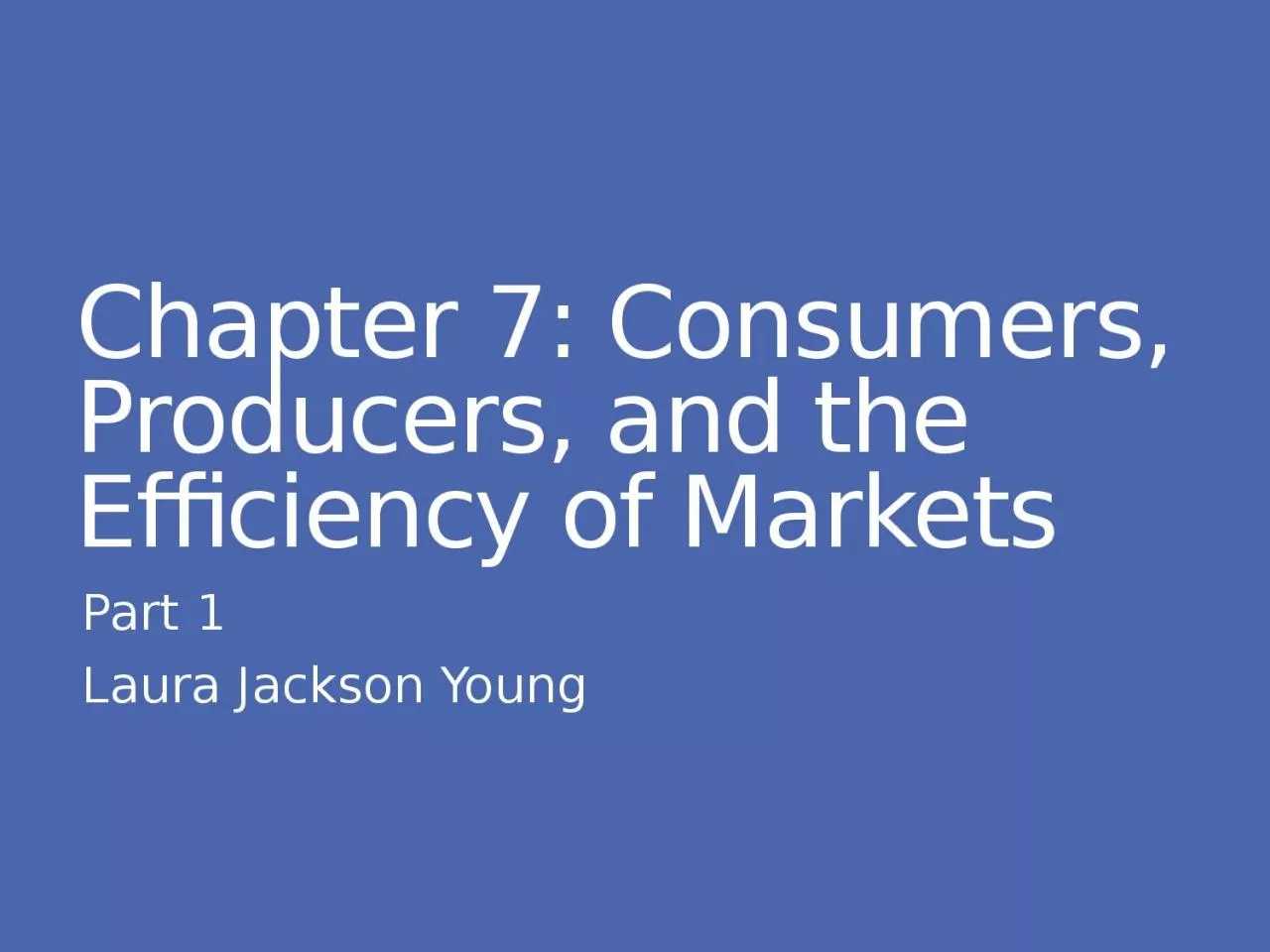

Part 1 Laura Jackson Young Welfare Economics The study of how the allocation of resources affects economic wellbeing Maximizing Behavior Net benefit total benefit of an activity minus its opportunity ID: 1028374
Download Presentation The PPT/PDF document "Chapter 7: Consumers, Producers, and the..." is the property of its rightful owner. Permission is granted to download and print the materials on this web site for personal, non-commercial use only, and to display it on your personal computer provided you do not modify the materials and that you retain all copyright notices contained in the materials. By downloading content from our website, you accept the terms of this agreement.
1. Chapter 7: Consumers, Producers, and the Efficiency of MarketsPart 1Laura Jackson Young
2. Welfare EconomicsThe study of how the allocation of resources affects economic well-being
3. Maximizing BehaviorNet benefit: total benefit of an activity minus its opportunity costMarginal benefit: the amount by which an additional unit of an activity increases its total benefitMarginal cost: the amount by which an additional unit of an activity increases its total cost
4. Decision-making at the MarginIf marginal benefit > marginal costIncrease quantityIf marginal benefit < marginal costDecrease quantity
5. Market EfficiencyEfficiency: Allocation of resources that maximizes total surplusEquity: The fairness of the distribution of well-being among the various buyers and sellers
6. Consumer SurplusWillingness to Pay (WTP): How much a buyer values a goodConsumer Surplus = WTP - Price
7. Example 1 – Textbook DemandBuyerBuyer Value (WTP)Mike$70Jenna$68Tony$66Megan$64Suppose the market price is $60
8. Example 1 – Textbook DemandBuyerBuyer Value (WTP)Consumer SurplusMike$70$10Jenna$68$8Tony$66$6Megan$64$4Suppose the market price is $60
9. PQDh$Consumer Surplus with Many Buyers
10. PQD1. Fall in CS due to buyers leaving market2. Fall in CS due to remaining buyers paying higher PHow a Higher Price Reduces CS
11. Producer SurplusWillingness to Sell (WTS): The amount for which a seller would be willing to sell a goodOpportunity cost of producingProducer Surplus = Price - WTS
12. Example 2 – Textbook SupplySellerSeller Cost (WTS)Patrick$20Shane$23Kristine$26Amanda$29Suppose the market price is $40
13. Example 2 – Textbook SupplySellerSeller Cost (WTS)Producer SurplusPatrick$20$20Shane$23$17Kristine$26$14Amanda$29$11Suppose the market price is $40
14. PQShProducer Surplus with Many Sellers
15. PQHow a Lower Price Reduces PSS1. Fall in PS due to sellers leaving market2. Fall in PS due to remaining sellersgetting lower P
16. Consumer and Producer Surplus
17. Chapter 7: Consumers, Producers, and the Efficiency of MarketsPart 2Laura Jackson Young
18. Efficiency with Supply and DemandQuantity per period
19. Efficiency with Supply and Demand
20. Market EfficiencySocial Planner: A hypothetical character whose sole responsibility is to maximize the economic well-being of a society
21. Market EfficiencyTotal Surplus = Consumer Surplus + Producer SurplusTotal Surplus = (Value to buyers - Amount paid by buyers) + (Amount received by sellers - Cost to sellers)Total Surplus = Value to buyers - Cost to sellers
22. Evaluating the Market EquilibriumMarket equilibrium: P = $30 Q = 15Total surplus = CS + PSIs the market equilibrium efficient?PQSDCSPS
23. Which Buyers Consume the Good?Every buyer whose WTP is ≥ $30 will buyEvery buyer whose WTP is < $30 will notThe buyers who value the good most highly are the ones who consume it. PQSD
24. Which Sellers Produce the Good?Every seller whose cost is ≤ $30 will produce the good. Every seller whose cost is > $30 will not. The sellers with the lowest cost produce the good.PQSD
25. Does Equilibrium Q Maximize Total Surplus?At Q = 20Cost of producing the marginal unit is $35 Value to consumers of the marginal unit is only $20Increase total surplus by reducing Q. This is true at any Q greater than 15. PQSD
26. Does Equilibrium Q Maximize Total Surplus?At Q = 10Cost of producing the marginal unit is $25 Value to consumers of the marginal unit is $40Increase total surplus by increasing Q. This is true at any Q less than 15. PQSD
27. Example 3 - WelfareIf Q1 units of the good were sold at a price of $P1, which areas represent the consumer surplus?The producer surplus?
28. Example 4 - WelfareDraw the supply/demand curves for the automobile marketIdentify the consumer surplus at equilibriumIdentify the producer surplus at the equilibrium
29. Chapter 7: Consumers, Producers, and the Efficiency of MarketsPart 3Laura Jackson Young
30. The Deadweight Loss of TaxationDeadweight Loss: Fall in total surplus that results from a market distortion, such as a taxTax Wedge: Difference between the amount consumers pay and the amount sellers receive for a productWill equal the amount of the taxDeadweight loss occurs because the quantity of output declines
31. C+E = Deadweight LossQE – QT = units not sold because of the taxPQDSPSPBQEQTABCDEFGeneral Effects of a Tax
32. Example 5 - WelfareAssume an automobile tax is levied. What happens to the consumer and producer surplus?How much tax revenue will the government collect?Compare:versus
33. Welfare effects of a taxS1PQD1$P*500450PB PSTaxCSPSTax RevenueDeadweight Loss
34. PQ$Compute CS, PS, and total surplus without a tax. If $100 tax per ticket, compute CS, PS, tax revenue, total surplus, and DWL.DSThe market for airplane ticketsExample 6 - Analysis of a Tax